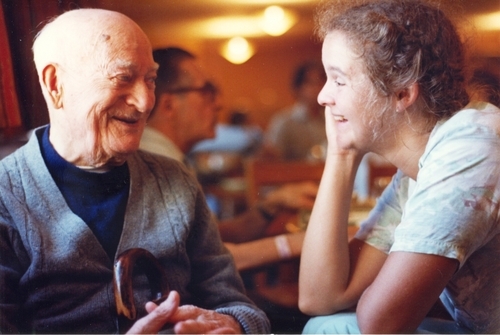Giles, Harold Trevor: my Air Force recollections (June 8, and August 4, 1983)
Interviewer: Bell, Chris
Rank: Squadron Leader. Medals and Honours: Distinguished Flying Cross (DFC)
Interviewee: Giles, Harold Trevor, b. 1922
ABSTRACT: Squadron Leader Harold Trevor Giles, D.F.C. Royal Canadian Air Force Giles_H_0078_01.mp3 (Side 1) Born to a farm family on July 17, 1922 near Gadsby, Alta. Joined the R.C.A.F. in Sept. 1940 although he had been a member of 91st Field Battery (militia) in Calgary. Applied for air crew. Manning depot, Toronto (30:00) followed by three months guard duty in Toronto and the maritimes. Comments on air crew selection, aircraft types. Guard duty: three hours on, four hours off. Anecdote. Initial Flying Training School at Guelph, Ont. (45:00) Giles_H_0078_02.mp3 Advanced training at Brantford, Ont. on the Avro Anson (training aircraft). Was awarded wings, a sergeant-pilot. Attended No. 1 General Reconnaissance School at Charlottetown, P.E.I. (15:00) Became a staff pilot at this R.A.F.-run base. Transferred out as soon as possible as promotion within the R.A.F. organization was slower than in the R.C.A.F. In 1942 was posted to No. 119 Bomber Squadron at Sydney, N.S. which used Bristol Bolingbroke bombers shortly to be replaced by the Lockheed Hudson. Comments on the three-point landing method of the former compared to the two-point method of the latter. Describes crash-landings with a bombload. Was transferred to No. 11 (Bomber) Squadron at Dartmouth, N.S. in March 1944 and commissioned. (50:00) Giles_H_0078_03.mp3 (Side 2) In mid-1944 converted to Consolidated Liberators (bomber). Describes aerial depth charges and accidents. Comments on tactics used when attacking submarines. (10:00) Air coverage usually thin on convoy patrol. Was ordered not to attack submarines seen on the flight to the convoy patrol area. Second duty to keep submarines under the surface as much as possible. The last year of the war saw early model Sonar buoys in use. Purpose of a bomber-reconnaissance squadron is explained. Was involved in the beginning of Tiger Force against Japan. (2:00) In March 1945 flew numbers of R.C.A.F. personnel from Iceland to Canada. Trained for the transport role. Flew Douglas Dakotas in No. 164 Squadron in the maritimes, then Liberators (No. 168 Squadron), carrying mail from Ottawa to Prestwick, Scotland. Commercial airlines attempted to recruit air force pilots with long-distance experience. Decided to stay in the R.C.A.F. Discusses terms of employment, retirement, promotion, and the service in general. (45:00) Giles_H_0078_04.mp3 In 1946 returned to No. 164 Squadron flying daily from Moncton to Goose Bay. Squadron number changed to No. 426. Beginning of Transport Command. (12:00) Made two flights to Japan during the Korean War, supplies in, wounded out. Personnel Branch in Ottawa. Staff College in Toronto. One year of jet aircraft training. In 1957 was posted to Comox, B.C., where he flew Avro CF-100 fighters. Comments on both the Canadair Sabre and the CF-100 fighters. Radar equipment. Early warning systems; Mid-Canada Line used the Doppler system. Giles_H_0078_05.mp3 Rotation of personnel at radar stations. Lack of accuracy of early inter continental ballistic missiles (I.C.B.M.). Was posted to defence headquarters about the time of the demise of the Avro Arrow. Dealt with operational requirements for the air force for the balance of his career. Retired in 1969. General discussion including Bomarc missiles, nuclear strike role in Canadair CF-104 squadrons, return to conventional weapons not entirely successful. Considers that unification produced confusion and a lack of efficiency. (48:00)
An interview/narrative of Harold Trevor Giles's experiences during World War II. Squadron Leader Giles, D.F.C. served with the Royal Canadian Air Force. Interview took place on June 8 and August 4, 1983.
- In Collection:
- Aerial reconnaissance
- Douglas DC-3 (Transport plane)
- Canada--RCAF Station (Guelph, Ont.)--Wireless School, 4
- Giles, Harold Trevor, b. 1922.--Interviews
- Canada--Royal Canadian Air Force--Squadron, 11
- Hudson (Bomber)
- Canada--Royal Canadian Air Force--Squadron, 119
- Canada--RCAF Station (Brantford, Ont.)--Service Flying Training School, 5
- Avro airplanes
- Great Britain--Royal Air Force--Bomber command--Tiger Force
- Canuck (Jet fighter plane)
- Submarine warfare
- World War, 1939-1945--Personal narratives, Canadian
- Sabre (Jet fighter plane)
- Canada--Royal Canadian Air Force
- Avro Anson (Training plane)
- B-24 bomber
- Canada--Royal Canadian Air Force--Squadron, 164
- Canada--Royal Canadian Air Force--Squadron, 168
- Canada--Canadian Armed Forces--Organization
- Lockheed aircraft
- Ballistic missiles
- Training planes
- Sonar
- British Commonwealth Air Training Plan
- Canada--Royal Canadian Air Force--Squadron, 426
- Doppler radar
- Transport planes
- Douglas airplanes
- Radar stations--Canada
- Canada--Royal Canadian Air Force--Military life
- Bombers
- Anti-submarine warfare
- Radar defense networks--Canada
- RAF Station (Charlottetown, P.E.I.)--General Reconnaissance School, 31
- Bolingbroke (Bomber)
- North American airplanes (Military aircraft)
- Bristol airplanes
- Canada--Royal Canadian Air Force--Transport Command
- 5 sound recordings (MP3)
- 60.10867, -113.64258
- 54.75844, -2.69531
- One original sound tape reel (ca. 180 min.) : 1 7/8 ips, 2 track, mono. ; 3 sound cassette copies : standard, mono. in Special Collections.
- Canadian Military Oral History Collection
- GHT_078
- Special Collections Finding Aid: https://search.archives.uvic.ca/reginald-herbert-roy-fonds
- June 8, 2007
- Digital sound recording in .wav format at 16 bits and 22 kHz. In .mp3 format at 64 kbps and 22 kHz. Digitized by AN, technical and cataloguing metadata provided by JF and JP. Transferred from audio reel to audio cassette between 1987-1997. Interview migrated to digital format for UVic Special Collections in 2007. Migration metadata by KD and MT.
- Rights
- This interview has been posted with the understanding that it may be used for research purposes only. Should the interviewee or their heirs have any objections to this interview being accessible on the Internet, it will be removed promptly. Contact UVic Special Collections for permission if using for other than research purposes: speccoll@uvic.ca
- DOI
| Thumbnail | Title | Date Uploaded | Actions |
|---|---|---|---|
|
|
SC141_MilitaryOralHistory_GenericThumbnail |
|
|

|
Giles_H_0078_01.mp3 |
|
|

|
Giles_H_0078_02.mp3 |
|
|

|
Giles_H_0078_03.mp3 |
|
|

|
Giles_H_0078_04.mp3 |
|
|

|
Giles_H_0078_05.mp3 |
|